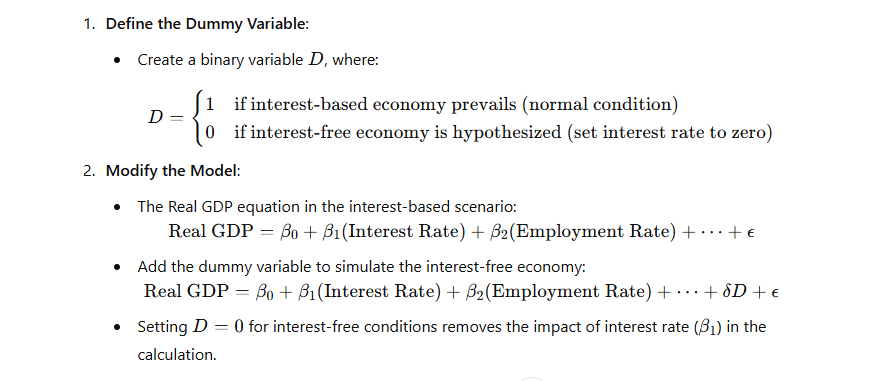The proposal of “Applied Islamic Economics” is innovative and aligns well with ongoing discussions in Islamic economics. It combines theoretical foundations with empirical analysis. By incorporating real-world case studies and modeling interest-free scenarios, this framework can provide a robust argument for the feasibility of a welfare state under Islamic principles.
Feasibility of Constructing an Islamic Economic System
- Principles: Islamic economics emphasizes welfare for all, ethical considerations, and the prohibition of interest (riba). It promotes risk-sharing, equitable distribution, and the integration of moral values in economic transactions.
- Case Studies: Analyzing real-world scenarios under an interest-based economy is straightforward due to abundant data. For an interest-free economy, while fewer examples exist, simulations and assumptions (e.g., dummy variables) can be used to model outcomes.
Brief Introduction to Applied Islamic Economics
We propose analyzing two scenarios:
- Interest-Based Economy:
- Factors such as interest rates, employment, inflation, and others impact GDP.
- Reflects a conventional economic model with tangible and intangible variables.
- Interest-Free Economy:
- Assumes zakat replaces interest as a redistributive tool.
- Focuses on welfare for all, emphasizing ethical growth, equitable distribution, and introducing moral values.
Key Considerations for Feasibility
- Modeling Real GDP:
- Interest-Based Formula: Real GDP=f (Interest Rate, Employment Rate, Inflation, Literacy Rate, Real Assets Growth, Social Welfare, Crime Ratio, Moral Values, State Tax Rate)
- Interest-Free Formula: Real GDP= f (Zakat, Employment Rate, Inflation, Literacy Rate, Islamic Taxes, Real Assets Growth, Welfare for All)
- Case Studies and Data:
- Interest-based economies have significant data availability.
- Interest-free economies like Pakistan’s zakat system or Islamic banking models in Malaysia can provide valuable insights.
- Hypothetical Models with Dummy Variables:
- When real-world examples are absent, use a dummy variable (e.g., setting interest rate = 0) to simulate interest-free scenarios.
- COVID-19 Pandemic Case Studies:
- Analyze how different regions implemented welfare measures during the pandemic.
- Assess whether the principles of Islamic economics (e.g., charity, solidarity) were informally adopted.
- Ethical and Moral Dimensions:
- Measure “moral values” and “social welfare” through proxies like crime rates, trust indices, and equitable access to resources.
Challenges
- Data Collection: Limited data on large-scale Islamic economies.
- Quantifying Moral Variables: Factors like “moral values” and “welfare for all” are subjective and hard to quantify.
- Acceptance of Assumptions: Using dummy variables or hypothetical constructs may face academic scrutiny.
Interest-Free Economy Through E-Views
Introducing a dummy variable to simulate an interest-free economy in E-Views can provide meaningful insights, even if real-world case studies are unavailable. Here’s how you can incorporate the zero dummy variable, interpret its effects, and analyze the outcomes:
Incorporating a Dummy Variable for an Interest-Free Economy
A dummy variable represents a binary condition (e.g., interest-based = 1, interest-free = 0). Here’s how to use it in EViews:

Steps in EViews
- Incorporate Data:
- Include historical data for Real GDP, interest rate, employment, and other variables.
- Add the dummy variable column (D) to your dataset.
- Set Interest Rate to Zero:
- For the interest-free scenario, replace interest rate values with zero where D=0.
- Run Regression:
- Use the modified Real GDP equation with the dummy variable:
ls RealGDP c InterestRate EmploymentRate Inflation LiteracyRate Dummy
- Use the modified Real GDP equation with the dummy variable:
- Compare Results:
- Estimate the model for both scenarios (D=1 and D=0).
- Analyze how the coefficients and significance levels change.
Interpretation
- Coefficient of Dummy Variable (δ):
- Measures the difference in Real GDP under the interest-free economy.
- A significant negative δ(delta) suggests the economy might struggle without interest. A significant positive δ indicates the interest-free model could boost GDP.
- Impact on Interest Rate (β1):
- Setting the interest rate to zero allows us to study the economy without interest.
- If β1 is small or insignificant in the interest-based scenario, the transition to interest-free might have minimal economic disruption.
- Alternative Variables:
- Analyze if other variables (e.g., zakat, Islamic taxes) gain more explanatory power in the absence of interest.
- Scenario Comparison:
- Use in-sample forecasts or simulations to compare GDP growth under both scenarios.
- Evaluate the contribution of moral and welfare variables.
Challenges in Interpretation
- Abrupt Change:
- In reality, setting the interest rate to zero abruptly (as in Pakistan) could disrupt financial markets.
- Dummy-based analysis assumes no sudden shock or adaptation cost.
- Assumption of Perfect Substitution:
- Assumes zakat or Islamic taxes will seamlessly replace interest-based mechanisms. Real-world implementation may differ.
- Policy Implications:
- Results must consider broader systemic effects, such as liquidity constraints and investor confidence.
Concluding Insights
Using a dummy variable to simulate an interest-free economy in E-Views is a valid approach to test hypotheses. However, the interpretation must account for practical challenges and policy nuances. This analysis can reveal whether an interest-free economy could sustain or enhance growth and welfare under Islamic principles.





